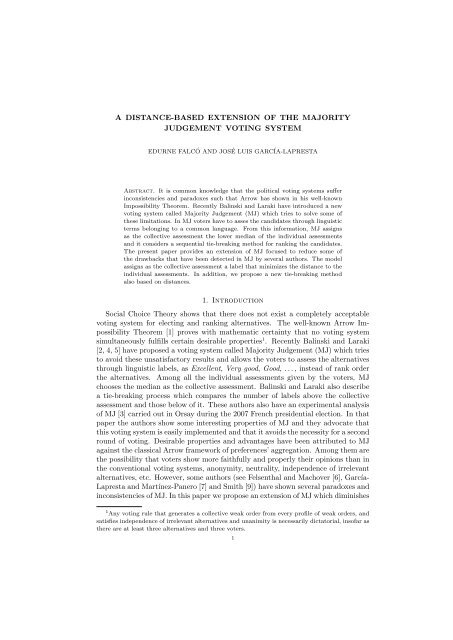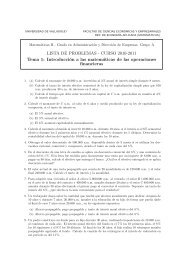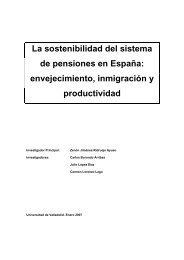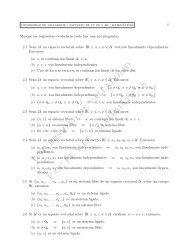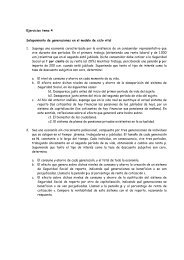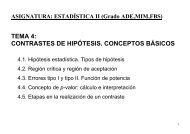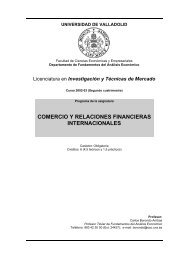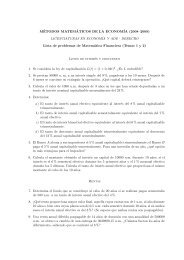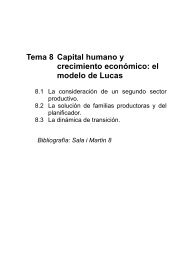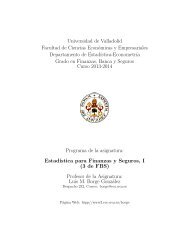A DISTANCE-BASED EXTENSION OF THE MAJORITY ...
A DISTANCE-BASED EXTENSION OF THE MAJORITY ...
A DISTANCE-BASED EXTENSION OF THE MAJORITY ...
You also want an ePaper? Increase the reach of your titles
YUMPU automatically turns print PDFs into web optimized ePapers that Google loves.
A <strong>DISTANCE</strong>-<strong>BASED</strong> <strong>EXTENSION</strong> <strong>OF</strong> <strong>THE</strong> <strong>MAJORITY</strong><br />
JUDGEMENT VOTING SYSTEM<br />
EDURNE FALCÓ AND JOSÉ LUIS GARCÍA-LAPRESTA<br />
Abstract. It is common knowledge that the political voting systems suffer<br />
inconsistencies and paradoxes such that Arrow has shown in his well-known<br />
Impossibility Theorem. Recently Balinski and Laraki have introduced a new<br />
voting system called Majority Judgement (MJ) which tries to solve some of<br />
these limitations. In MJ voters have to asses the candidates through linguistic<br />
terms belonging to a common language. From this information, MJ assigns<br />
as the collective assessment the lower median of the individual assessments<br />
and it considers a sequential tie-breaking method for ranking the candidates.<br />
The present paper provides an extension of MJ focused to reduce some of<br />
the drawbacks that have been detected in MJ by several authors. The model<br />
assigns as the collective assessment a label that minimizes the distance to the<br />
individual assessments. In addition, we propose a new tie-breaking method<br />
also based on distances.<br />
1. Introduction<br />
Social Choice Theory shows that there does not exist a completely acceptable<br />
voting system for electing and ranking alternatives. The well-known Arrow Impossibility<br />
Theorem [1] proves with mathematic certainty that no voting system<br />
simultaneously fulfills certain desirable properties 1 . Recently Balinski and Laraki<br />
[2, 4, 5] have proposed a voting system called Majority Judgement (MJ) which tries<br />
to avoid these unsatisfactory results and allows the voters to assess the alternatives<br />
through linguistic labels, as Excellent, Very good, Good, . . . , instead of rank order<br />
the alternatives. Among all the individual assessments given by the voters, MJ<br />
chooses the median as the collective assessment. Balinski and Laraki also describe<br />
a tie-breaking process which compares the number of labels above the collective<br />
assessment and those below of it. These authors also have an experimental analysis<br />
of MJ [3] carried out in Orsay during the 2007 French presidential election. In that<br />
paper the authors show some interesting properties of MJ and they advocate that<br />
this voting system is easily implemented and that it avoids the necessity for a second<br />
round of voting. Desirable properties and advantages have been attributed to MJ<br />
against the classical Arrow framework of preferences’ aggregation. Among them are<br />
the possibility that voters show more faithfully and properly their opinions than in<br />
the conventional voting systems, anonymity, neutrality, independence of irrelevant<br />
alternatives, etc. However, some authors (see Felsenthal and Machover [6], García-<br />
Lapresta and Martínez-Panero [7] and Smith [9]) have shown several paradoxes and<br />
inconsistencies of MJ. In this paper we propose an extension of MJ which diminishes<br />
1 Any voting rule that generates a collective weak order from every profile of weak orders, and<br />
satisfies independence of irrelevant alternatives and unanimity is necessarily dictatorial, insofar as<br />
there are at least three alternatives and three voters.<br />
1
2 EDURNE FALCÓ AND JOSÉ LUIS GARCÍA-LAPRESTA<br />
some of the MJ inconveniences. The approach of the paper is distance-based, both<br />
for generating a collective assessment of each alternative and in the tie-breaking<br />
process that provides a weak order on the set of alternatives. As in MJ we consider<br />
that individuals assess the alternatives through linguistic labels and we propose<br />
as the collective assessment a label that minimizes the distance to the individual<br />
assessments. These distances between linguistic labels are induced by a metric of<br />
the parameterized Minkowski family. Depending on the specific metric we use, the<br />
discrepancies between the collective and the individual assessments are weighted<br />
in a different manner, and the corresponding outcome can be different. The paper<br />
is organized as follows. In Section 2, the MJ voting system is formally explained.<br />
Section 3 introduces our proposal, within a distance-based approach. Specifically,<br />
the election of the collective assessment for each alternative and the tie-breaking<br />
method are introduced. In Section 4 we include two illustrative examples showing<br />
the influence of the metric used in the proposed method and its differences with<br />
respect to MJ and Range Voting (Smith [9]). Finally, in Section 5 we collect some<br />
conclusions.<br />
2. Majority Judgement<br />
We consider 2 a finite set of voters V = {1, . . . , m}, with m ≥ 2, who evaluate<br />
a finite set of alternatives X = {x 1 , . . . , x n }, with n ≥ 2. Each alternative is<br />
assessed by each voter through a linguistic term belonging to an ordered finite scale<br />
L = {l 1 , . . . , l g }, with l 1 < · · · < l g and granularity g ≥ 2. Each voter assesses the<br />
alternatives ( ) in an independent way and these assessments are collected by a matrix<br />
v<br />
i<br />
j , where v<br />
i<br />
j ∈ L is the assessment that the voter i gives to the alternative<br />
x j . MJ chooses for each alternative the median of the individual assessment as<br />
the collective assessment. To be precise, the single median when the number of<br />
voters is odd and the lower median in the case that the number of voters is even.<br />
We denote with l(x j ) the collective assessment of the alternative x j . Given that<br />
several alternatives might share the same collective assessment, Balinski and Laraki<br />
[2] propose a sequential tie-breaking process. This can be described through the<br />
following terms (see García-Lapresta and Martínez-Panero [7]):<br />
N + (x j ) = #{i ∈ V | v i j > l(x j )} , N − (x j ) = #{i ∈ V | v i j < l(x j )}<br />
and<br />
⎧<br />
⎪⎨<br />
−1, if N + (x j ) < N − (x j ),<br />
t(x j ) = 0, if N + (x j ) = N − (x j ),<br />
⎪⎩<br />
1, if N + (x j ) > N − (x j ).<br />
Taking into account the collective assessments and the previous indices, we define<br />
a weak order 3 ≽ on X in the following way: x j ≽ x k if and only if one of the<br />
following conditions hold:<br />
(1) l(x j ) > l(x k ).<br />
(2) l(x j ) = l(x k ) and t(x j ) > t(x k ).<br />
(3) l(x j ) = l(x k ), t(x j ) = t(x k ) = 1 and N + (x j ) > N + (x k ).<br />
2 The current notation is similar to the one introduced by García-Lapresta and Martínez-Panero<br />
[7]. This allows us to describe the MJ process, presented by Balinski and Laraki [2], in a more<br />
precise way.<br />
3 A weak order (or complete preorder) is a complete and transitive binary relation.
A <strong>DISTANCE</strong>-<strong>BASED</strong> <strong>EXTENSION</strong> <strong>OF</strong> <strong>THE</strong> <strong>MAJORITY</strong> JUDGEMENT VOTING SYSTEM 3<br />
(4) l(x j ) = l(x k ), t(x j ) = t(x k ) = 1, N + (x j ) = N + (x k ) and<br />
N − (x j ) ≤ N − (x k ).<br />
(5) l(x j ) = l(x k ), t(x j ) = t(x k ) = 0 and<br />
m − N + (x j ) − N − (x j ) ≥ m − N + (x k ) − N − (x k ).<br />
(6) l(x j ) = l(x k ), t(x j ) = t(x k ) = −1 and N − (x j ) < N − (x k ).<br />
(7) l(x j ) = l(x k ), t(x j ) = t(x k ) = −1, N − (x j ) = N − (x k ) and<br />
N + (x j ) ≥ N + (x k ).<br />
The asymmetric and symmetric parts of ≽ are defined in the usual way:<br />
x j ≻ x k ⇔ not x k ≽ x j<br />
x j ∼ x k ⇔ (x j ≽ x k and x k ≽ x j ).<br />
Next an example of how MJ works is shown.<br />
Example 1. Consider three alternatives x 1 , x 2 and x 3 that are evaluated by<br />
seven voters through a set of six linguistic terms L = {l 1 , . . . , l 6 }, the same set<br />
used in MJ [3], whose meaning is shown in Table 1. The assessments obtained for<br />
Table 1. Meaning of the linguistic terms<br />
l 1 l 2 l 3 l 4 l 5 l 6<br />
To reject Poor Acceptable Good Very good Excellent<br />
each alternative are collected and ranked from the lowest to the highest in Table<br />
2. For ranking the three alternatives, first we take the median of the individual<br />
Table 2. Assessments of Example 1<br />
x 1 l 1 l 1 l 3 l 5 l 5 l 5 l 6<br />
x 2 l 1 l 4 l 4 l 4 l 4 l 5 l 6<br />
x 3 l 1 l 3 l 4 l 4 l 5 l 5 l 5<br />
assessments, that will be the collective assessment for each one of the mentioned<br />
alternatives: l(x 1 ) = l 5 , l(x 2 ) = l 4 and l(x 3 ) = l 4 . Given that x 1 has the<br />
best collective assessment, it will be the one ranked in first place. However, the<br />
alternatives x 2 and x 3 share the same collective assessment, we need to turn to the<br />
tie-breaking process, where we obtain N + (x 2 ) = 2, N − (x 2 ) = 1 and t(x 2 ) = 1;<br />
N + (x 3 ) = 3, N − (x 3 ) = 2 and t(x 3 ) = 1. Since both alternatives have the same<br />
t (t(x 2 ) = t(x 3 ) = 1), we should compare their N + : N + (x 2 ) = 2 < 3 = N + (x 3 ).<br />
Therefore, the alternative x 3 defeats the alternative x 2 , and the final order is<br />
x 1 ≻ x 3 ≻ x 2 .<br />
3. Distance-based method<br />
In this section the alternative method to MJ that we propose through a distancebased<br />
approach is introduced. The first step for ranking the alternatives is to assign<br />
a collective assessment l(x j ) ∈ L to each alternative x j ∈ X. For its calculation,<br />
the vectors (vj 1, . . . , vm j ) that collect all the individual assessments for each alternative<br />
x j ∈ X are taken into account. The proposal, that is detailed below,
4 EDURNE FALCÓ AND JOSÉ LUIS GARCÍA-LAPRESTA<br />
involves how to choose a l(x j ) ∈ L that minimizes the distance between the vector<br />
of individual assessments (v 1 j , . . . , vm j ) and the vector (l(x j), . . . , l(x j )) ∈ L m .<br />
The election of that term is performed in an independent way for each alternative.<br />
This guarantees the fulfillment of the independence of irrelevant alternatives principle<br />
4 . Once a collective assessment l(x j ) has been associated with each alternative<br />
x j ∈ X , we rank the alternatives according to the ordering of L. Given the possible<br />
existence of ties, we also propose a sequential tie-breaking process based on the<br />
difference between the distance of l(x j ) to the assessments higher than l(x j ) and<br />
the distance of l(x j ) to the assessments lower than l(x j ).<br />
3.1. Distances. A distance or metric on R m is a mapping d : R m ×R m −→ R that<br />
fulfills the following conditions for all (a 1 , . . . , a m ), (b 1 , . . . , b m ), (c 1 , . . . , c m ) ∈ R m :<br />
(1) d((a 1 , . . . , a m ), (b 1 , . . . , b m )) ≥ 0.<br />
(2) d((a 1 , . . . , a m ), (b 1 , . . . , b m )) = 0 ⇔ (a 1 , . . . , a m ) = (b 1 , . . . , b m ).<br />
(3) d((a 1 , . . . , a m ), (b 1 , . . . , b m )) = d((b 1 , . . . , b m ), (a 1 , . . . , a m )).<br />
(4) d((a 1 , . . . , a m ), (b 1 , . . . , b m )) ≤<br />
d((a 1 , . . . , a m ), (c 1 , . . . , c m )) + d((c 1 , . . . , c m ), (b 1 , . . . , b m )).<br />
Given a distance d : R m × R m −→ R, the distance on L m induced by d is the<br />
mapping ¯d : L m × L m −→ R defined by<br />
¯d((l a1 , . . . , l am ), ((l b1 , . . . , l bm )) = d((a 1 , . . . , a m ), (b 1 , . . . , b m )).<br />
An important class of distances in R m is constituted by the family of Minkowski<br />
distances {d p | p ≥ 1}, which are defined by<br />
( m<br />
) 1<br />
p<br />
∑<br />
d p ((a 1 , . . . , a m ), (b 1 , . . . , b m )) = |a i − b i | p ,<br />
for all (a 1 , . . . , a m ), (b 1 , . . . , b m ) ∈ R m . We choose this family due to the fact that<br />
it is parameterized and it includes from the well-known Manhattan (p = 1) and<br />
Euclidean (p = 2) distances, to the limit case, the Chebyshev distance (p = ∞). The<br />
possibility of choosing among different values of p ∈ (1, ∞) gives us a very flexible<br />
method, and we can choose the most appropriate p according to the objectives we<br />
want to achieve with the election. Given a Minkowski distance on R m , we consider<br />
the induced distance on L m which works with the assessments vector through the<br />
subindexes of the corresponding labels:<br />
¯d p ((l a1 , . . . , l am ), (l b1 , . . . , l bm )) = d p ((a 1 , . . . , a m ), (b 1 , . . . , b m )).<br />
Remark 1. The ordinal scale of linguistic terms we use, L, is just a finite scale<br />
whose consecutive terms are equidistant. Following Balinski and Laraki [2], each<br />
term of the scale has associated a linguistic label. What matters is not the name<br />
of the label but the position of the label in the ordinal scale. This is the reason<br />
we consider the number of changes we need for going from a term to another one 5 .<br />
In this sense, the distance between two labels’ vectors is based on the number of<br />
positions that we need to cover to go from one to another, in each of its components.<br />
To move from l ai to l bi we need to cover |a i − b i | positions. For instance between<br />
4 This principle says that the relative ranking between two alternatives would only depend on<br />
the preference or assessments on these alternatives and must not be affected by other alternatives,<br />
that must be irrelevant on that comparison.<br />
5 This is not exactly the same that identifying each linguistic label with a number.<br />
i=1
A <strong>DISTANCE</strong>-<strong>BASED</strong> <strong>EXTENSION</strong> <strong>OF</strong> <strong>THE</strong> <strong>MAJORITY</strong> JUDGEMENT VOTING SYSTEM 5<br />
l 5 and l 2 we need to cover |5 − 2| = 3 positions: from l 5 to l 4 , from l 4 to l 3 and<br />
from l 3 to l 2 .<br />
3.2. Election of a collective assessment for each alternative. Our proposal<br />
is divided into several stages. First we assign a collective assessment l(x j ) ∈ L<br />
to each alternative x j ∈ X which minimizes the distance between the vector of<br />
the individual assessments, (v 1 j , . . . , vm j ) ∈ Lm , and the vector of m replicas of the<br />
desired collective assessment, (l(x j ), . . . , l(x j )) ∈ L m . For this, first we establish<br />
the set L(x j ) of all the labels l k ∈ L satisfying<br />
¯d p ((v 1 j , . . . , v m j ), (l k , . . . , l k )) ≤ ¯d p ((v 1 j , . . . , v m j ), (l h , . . . , l h )),<br />
for each l h ∈ L, where (l h , . . . , l h ) and (l k , . . . , l k ) are the vectors of m replicas<br />
of l h and l k , respectively. Thus, L(x j ) consists of those labels that minimize the<br />
distance to the vector of individual assessments. Notice that L(x j ) = {l r , . . . , l r+s }<br />
is always an interval, because it contains all the terms from l r to l r+s , where<br />
r ∈ {1, . . . , g} and 0 ≤ s ≤ g − r. Two different cases are possible:<br />
(1) If s = 0, then L(x j ) contains a single label, which will automatically be<br />
the collective assessment l(x j ) of the alternative x j .<br />
(2) If s > 0, then L(x j ) has more than one label. In order to select the most<br />
suitable label of L(x j ), we now introduce L ∗ (x j ), the set of all the labels<br />
l k ∈ L(x j ) that fulfill<br />
¯d p ((l k , . . . , l k ), (l r , . . . , l r+s ))≤ ¯d p ((l h , . . . , l h ), (l r , . . . , l r+s )),<br />
for all l h ∈ L(x j ), where (l k , . . . , l k ) and (l h , . . . , l h ) are the vectors of<br />
s + 1 replicas of l k and l h , respectively.<br />
(a) If the cardinality of L(x j ) is odd, then L ∗ (x j ) has a unique label, the<br />
median term, that will be the collective assessment l(x j ).<br />
(b) If the cardinality of L(x j ) is even, then L ∗ (x j ) has two different<br />
labels, the two median terms. In this case, similarly to the proposal<br />
of Balinski and Laraki [2], we consider the lowest label in L ∗ (x j ) as<br />
the collective assessment l(x j ).<br />
It is worth pointing out two different cases when we are using induced Minkowski<br />
distances.<br />
(1) If p = 1, we obtain the same collective assessments that those given by MJ,<br />
the median 6 of the individual assessments. However, the final results are<br />
not necessarily the same that in MJ because we use a different tie-breaking<br />
process, as is shown later.<br />
(2) If p = 2, each collective assessment is the closest label to the “mean” of<br />
the individual assessments 7 , which is the one chosen by the Range Voting<br />
(RV) method 8 (see Smith [9]).<br />
It is interesting to note that when we choose p ∈ (1, 2), we find situations where the<br />
collective assessment is located between the median and the “mean”. This allows<br />
6 It is more precise to speak about the interval of medians, because if the assessments’ vector<br />
has an even number of components, then there are more than one median. See Monjardet [8].<br />
7 The chosen label is not exactly the arithmetic mean of the individual assessments, because<br />
we are working with a discrete spectrum of linguistic terms and not in the continuous one of the<br />
set of real numbers.<br />
8 RV works with a finite scale given by equidistant real numbers, and it ranks the alternatives<br />
according to the arithmetic mean of the individual assessments.
6 EDURNE FALCÓ AND JOSÉ LUIS GARCÍA-LAPRESTA<br />
us to avoid some of the problems associated with MJ and RV. See García-Lapresta<br />
and Martínez-Panero [7] for a different proposal based on centered OWA operators<br />
(Yager [10]).<br />
3.3. Tie-breaking method. Usually there exist more alternatives than linguistic<br />
terms, so it is very common to find several alternatives sharing the same collective<br />
assessment. But irrespectively of the number of alternatives, it is clear that<br />
some of them may share the same collective assessment, even when the individual<br />
assessments are very different. For these reasons it is necessary to introduce<br />
a tie-breaking method that takes into account not only the number of individual<br />
assessments above or below the obtained collective assessment (as in MJ), but the<br />
positions of these individual assessments in the ordered scale associated with L. As<br />
mentioned above, we will calculate the difference between two distances: one between<br />
l(x j ) and the assessments higher than l(x j ) and another one between l(x j )<br />
and the assessments lower than the l(x j ). Let v + j and v − j the vectors composed<br />
by the assessments vj<br />
i from ( vj 1, . . . , ) vm j higher and lower than the term l(xj ),<br />
respectively. First we calculate the two following distances:<br />
D + (x j ) = ¯d p<br />
(<br />
v<br />
+<br />
j , (l(x j), . . . , l(x j )) ) ,<br />
D − (x j ) = ¯d p<br />
(<br />
v<br />
−<br />
j , (l(x j), . . . , l(x j )) ) ,<br />
where the number of components of (l(x j ), . . . , l(x j )) is the same that in v + j and<br />
in v − j , respectively (obviously, the number of components of v + j and v − j can be<br />
different). Once these distances have been determined, a new index D(x j ) ∈ R<br />
is calculated for each alternative x j ∈ X: the difference between the two previous<br />
distances:<br />
D(x j ) = D + (x j ) − D − (x j ).<br />
By means of this index, we provide a kind of compensation between the individual<br />
assessments that are bigger and smaller than the collective assessment, taking into<br />
account the position of each assessment in the ordered scale associated with L.<br />
For introducing our tie-breaking process, we finally need the distance between the<br />
individual assessments and the collective one:<br />
E(x j ) = ¯d p<br />
(<br />
(v<br />
1<br />
j , . . . , v m j ), (l(x j ), . . . , l(x j )) ) .<br />
Notice that for each alternative x j ∈ X, E(x j ) minimizes the distance between<br />
the vector of individual assessments and the linguistic labels in L, such as has<br />
been considered above in the definition of L(x j ). The use of the index E(·) is<br />
important in the tie-breaking process because if two alternatives share the same<br />
couple (l(·), D(·)), the alternative with the lower E(·) is the alternative whose<br />
individual assessments are more concentrated around the collective assessment, i.e.,<br />
the consensus is higher. Summarizing, for ranking the alternatives we will consider<br />
the following triplet<br />
T (x j ) = (l(x j ), D(x j ), E(x j )) ∈ L × R × [0, ∞)<br />
for each alternative x j ∈ X. The sequential process works in the following way:<br />
(1) We rank the alternatives through the collective assessments l(·). The alternatives<br />
with higher collective assessments will be preferred to those with<br />
lower collective assessments.
A <strong>DISTANCE</strong>-<strong>BASED</strong> <strong>EXTENSION</strong> <strong>OF</strong> <strong>THE</strong> <strong>MAJORITY</strong> JUDGEMENT VOTING SYSTEM 7<br />
(2) If several alternatives share the same collective assessment, then we break<br />
the ties through the D(·) index. The alternatives with a higher D(·) will<br />
be preferred.<br />
(3) If there are still ties, we break them through the E(·) index, in such a way<br />
such that the alternatives with a lower E(·) will be preferred.<br />
Formally, the sequential process can be introduced by means of the lexicographic<br />
weak order ≽ on X defined by x j ≽ x k if and only if<br />
(1) l(x j ) ≥ l(x k ) or<br />
(2) l(x j ) = l(x k ) and D(x j ) > D(x k ) or<br />
(3) l(x j ) = l(x k ), D(x j ) = D(x k ) and E(x j ) ≤ E(x k ).<br />
Remark 2. Although it is possible that ties still exist, whenever two or more<br />
alternatives share T (·), these cases are very unusual when considering metrics with<br />
p > 1. 9 For instance, consider seven voters that assess two alternatives x 1 and x 2<br />
by means of the set of linguistic terms given in Table 1. Table 3 includes these<br />
assessments arranged from the lowest to the highest labels. It is easy to see that<br />
Table 3. Individual assessments<br />
x 1 l 2 l 2 l 2 l 2 l 4 l 4 l 6<br />
x 2 l 2 l 2 l 2 l 2 l 3 l 5 l 6<br />
for p = 1 we have T (x 1 ) = T (x 2 ) = (l 2 , 8, 8), then x 1 ∼ x 2 (notice that MJ and<br />
RV also provide a tie). However, if p > 1, the tie disappears. So, we have x 2 ≻ x 1 ,<br />
excepting for p ∈ (1.179, 1.203), where x 1 ≻ x 2 .<br />
4. Two illustrative examples<br />
This section focus on how the election of the parameter p is relevant in the final<br />
ranking of the alternatives. We show this fact through two different examples. The<br />
first one considers a case where the median of the individual assessments is the<br />
same for all the alternatives. And the second one considers a situation where the<br />
mean of the individual assessments’ subindexes is the same for all the alternatives.<br />
In both examples we use the set of six linguistic terms L = {l 1 , . . . , l 6 } whose<br />
meaning is shown in Table 1. As mentioned above, the sequential process for<br />
ranking the alternatives is based on the triplet T (x j ) = (l(x j ), D(x j ), E(x j )) for<br />
each alternative x j ∈ X. However, by simplicity, in the following examples we only<br />
show the first two components, (l(x j ), D(x j )). In these examples we also obtain<br />
the outcomes provided by MJ and RV.<br />
Example 2. Table 4 includes the assessments given by six voters to four alternatives<br />
x 1 , x 2 , x 3 and x 4 arranged from the lowest to the highest labels. Notice<br />
that the mean of the individual assessments’ subindexes is the same for the four<br />
21<br />
alternatives,<br />
6<br />
= 3.5. Since RV ranks the alternatives according to this mean,<br />
it produces a tie x 1 ∼ x 2 ∼ x 3 ∼ x 4 . However, it is clear that this outcome<br />
might not seem reasonable, and that other rankings could be justified. Using MJ,<br />
where l(x 1 ) = l(x 4 ) = l 4 > l 3 = l(x 2 ) > l 2 = l(x 3 ) and, according to the MJ<br />
9 The Manhattan metric (p = 1) produces more ties than the other metrics in the Minkowski<br />
family because of the simplicity of its calculations.
8 EDURNE FALCÓ AND JOSÉ LUIS GARCÍA-LAPRESTA<br />
Table 4. Assessments in Example 2<br />
x 1 l 1 l 2 l 4 l 4 l 4 l 6<br />
x 2 l 1 l 1 l 3 l 4 l 6 l 6<br />
x 3 l 2 l 2 l 2 l 4 l 5 l 6<br />
x 4 l 1 l 1 l 4 l 5 l 5 l 5<br />
tie-breaking process, we have t(x 1 ) = −1 < 1 = t(x 4 ). Thus, MJ produces the outcome<br />
x 4 ≻ x 1 ≻ x 2 ≻ x 3 . We now consider the distance-based procedure for seven<br />
values of p. In Table 5 we can see the influence of these values on (l(x j ), D(x j )), for<br />
j = 1, 2, 3. The corresponding rankings are included in Table 6. For p = 1, we have<br />
Table 5. (l(x j ), D(x j )) in Example 2<br />
p = 1 p = 1.25 p = 1.5 p = 1.75 p = 2 p = 5 p = 10<br />
x 1 (l 4 , −3) (l 4 , −2.375) (l 4 , −2.008) (l 4 , −1.770) (l 3 , 1.228) (l 3 , 0.995) (l 3 , 0.000)<br />
x 2 (l 3 , 10) (l 3 , 2.264) (l 3 , 1.888) (l 3 , 1.669) (l 3 , 1.530) (l 3 , 1.150) (l 3 , 1.072)<br />
x 3 (l 2 , 9) (l 3 , 2.511) (l 3 , 2.254) (l 3 , 2.104) (l 3 , 2.010) (l 4 , −0.479) (l 4 , −0.232)<br />
x 4 (l 4 , −3) (l 4 , −2.815) (l 4 , −2.682) (l 4 , −2.585) (l 3 , 0.777) (l 3 , 0.199) (l 3 , 0.089)<br />
Table 6. Rankings in Example 2<br />
MJ p = 1 p = 1.25 p = 1.5 p = 1.75 p = 2 p = 5 p = 10<br />
x 4 x 1 x 1 x 1 x 1 x 3 x 3 x 3<br />
x 1 x 4 x 4 x 4 x 4 x 2 x 2 x 2<br />
x 2 x 2 x 3 x 3 x 3 x 1 x 1 x 1<br />
x 3 x 3 x 2 x 2 x 2 x 4 x 4 x 4<br />
T (x 1 ) = (l 4 , −3, 7), T (x 2 ) = (l 3 , 10, 11), T (x 3 ) = (l 2 , 9, 9) and T (x 4 ) = (l 4 , −3, 9).<br />
Then, we obtain the ranking x 1 ≻ x 4 ≻ x 2 ≻ x 3 , a different outcome than obtained<br />
using MJ. For p = 1.25, p = 1.5 and p = 1.75, we obtain x 1 ≻ x 4 ≻ x 3 ≻ x 2 ; and<br />
for p = 2, p = 5 and p = 10, we have x 3 ≻ x 2 ≻ x 1 ≻ x 4 .<br />
Example 3. Similarly to the previous example, Table 7 includes the assessments<br />
given by seven voters to three alternatives x 1 , x 2 and x 3 arranged from the lowest<br />
to the highest labels. Clearly, the individual assessments of the three alternatives<br />
Table 7. Assessments in Example 3<br />
x 1 l 1 l 1 l 2 l 3 l 6 l 6 l 6<br />
x 2 l 2 l 3 l 3 l 3 l 6 l 6 l 6<br />
x 3 l 3 l 3 l 3 l 3 l 4 l 4 l 4<br />
share the same median, l 3 . According to the MJ tie-breaking process, we have<br />
t(x 1 ) = 0 < 1 = t(x 2 ) = t(x 3 )<br />
N + (x 1 ) = N + (x 2 ) = N + (x 3 ) = 3<br />
N − (x 3 ) = 0 < 1 = N − (x 2 ) < 3 = N − (x 1 ).
A <strong>DISTANCE</strong>-<strong>BASED</strong> <strong>EXTENSION</strong> <strong>OF</strong> <strong>THE</strong> <strong>MAJORITY</strong> JUDGEMENT VOTING SYSTEM 9<br />
Thus, MJ produces the outcome x 3 ≻ x 2 ≻ x 1 . This outcome does not seem logical,<br />
because x 2 has a clear advantage over x 3 . On the other hand, RV ranks order the<br />
alternatives as follows: x 2 ≻ x 1 ≻ x 3 , since the mean of the individual assessments’<br />
subindexes are 3.571, 4.143 and 3.429 for x 1 , x 2 and x 3 , respectively. We now<br />
consider the distance-based procedure for seven values of p, the same considered in<br />
the previous example. Table 8 shows the influence of these values on (l(x j ), D(x j )),<br />
for j = 1, 2, 3. Notice that in this example the same ranking is obtained for all the<br />
Table 8. (l(x j ), D(x j )) in Example 3<br />
p = 1 p = 1.25 p = 1.5 p = 1.75 p = 2 p = 5 p = 10<br />
x 1 (l 3 , 4) (l 3 , 3.168) (l 3 , 2.702) (l 4 , −1.475) (l 4 , −1.332) (l 4 , −1.000) (l 4 , −0.986)<br />
x 2 (l 3 , 8) (l 4 , 0.975) (l 4 , 0.922) (l 4 , 0.868) (l 4 , 0.818) (l 4 , 0.455) (l 4 , 0.235)<br />
x 3 (l 3 , 3) (l 3 , 2.408) (l 3 , 2.080) (l 3 , 1.873) (l 3 , 1.732) (l 3 , 1.246) (l 3 , 1.116)<br />
considered values of p: x 2 ≻ x 1 ≻ x 3 . This outcome coincides with RV, and it is<br />
more consistent than that obtained by MJ.<br />
5. Concluding remarks<br />
In this paper we have presented an extension of the Majority Judgement voting<br />
system developed by Balinski and Laraki [2, 3, 4, 5]. This extension is based on a<br />
distance approach but it also uses linguistic labels to evaluate the alternatives. We<br />
choose as the collective assessment for each alternative a label that minimizes the<br />
distance to the individual assessments. It is important to note that our proposal<br />
coincides in this aspect with Majority Judgement whenever the Manhattan metric<br />
is used. We also provide a tie-breaking process through the distances between<br />
the individual assessments higher and lower than the collective one. This process is<br />
richer than the one provided by Majority Judgement, which only counts the number<br />
of alternatives above or below the collective assessment, irrespectively of what they<br />
are. We also note that our tie-breaking process is essentially different to Majority<br />
Judgement even when the Manhattan metric is considered. It is important to<br />
note that using the distance-based approach we pay attention to all the individual<br />
assessments that have not been chosen as the collective assessment. With the<br />
election of a specific metric of the Minkowski family we are deciding how to evaluate<br />
these other assessments. We may distinguish four cases:<br />
(1) If p = 1, the collective assessment is just the median label and no other<br />
individual assessment is relevant in this stage. However, in the tie-breaking<br />
process, all the individual assessments are taken into account, and each of<br />
them with the same weight or importance.<br />
(2) If p = 2, the collective assessment is a kind of “mean” of the individual<br />
assessments because it minimizes the Euclidean distance to the individual<br />
assessments. In this stage all the voters have the same importance.<br />
However, in the tie-breaking process we are giving more importance to the<br />
assessment that are further to the collective assessment than to those labels<br />
that are closer to the collective assessment.<br />
(3) If p ∈ (1, 2), we are moving between the two previous cases. Higher values of<br />
p give more importance to extreme individual assessments and lower values<br />
of p give more importance to individual assessments near the median one.
10 EDURNE FALCÓ AND JOSÉ LUIS GARCÍA-LAPRESTA<br />
(4) If p ∈ (2, ∞), the collective assessment depends more on the extreme assessments<br />
than on the central ones, being more intense this dependency as<br />
higher the p is. If they are balanced in both sides, this has not effect in<br />
the final outcome. But if one of the sides has more extreme opinions, the<br />
collective label will go close to them. The tie-breaking process gives also<br />
more weight to the extreme opinions.<br />
These aspects provide flexibility to our extension and it allows to devise a wide<br />
class of voting systems that may avoid some of the drawbacks related to Majority<br />
Judgement and Range Voting without losing their good features. This becomes<br />
specially interesting when the value of the parameter p in the Minkowski family<br />
belongs to the open interval (1, 2), since p = 1 and p = 2 correspond to the Manhattan<br />
and the Euclidean metrics, respectively, just the metrics used in Majority<br />
Judgement and Range Voting. For instance, the election of p = 1.5 allows us to<br />
have a kind of compromise between both methods. As shown in the previous examples,<br />
when the value of parameter p increases, the distance-based procedure focuses<br />
more and more on the extreme assessments. However, if the individual assessments<br />
are well balanced on both sides, the outcome is not very affected by the parameter<br />
p. In further research we will analyze the properties of the presented extension of<br />
Majority Judgement within the Social Choice framework.<br />
Acknowledgments<br />
The authors are grateful to the members of the PRESAD Research Group,<br />
Jorge Alcalde-Unzu and two anonymous referees for their comments and suggestions.<br />
The financial support of the Spanish Ministerio de Ciencia e Innovación<br />
(projects ECO2009-07332, ECO2009-12836 and ECO2008-03204-E/ECON), ERDF<br />
and Junta de Castilla y León (Consejería de Educación, Projects VA092A08 and<br />
GR99) are also gratefully acknowledged.<br />
References<br />
[1] K. J. Arrow. Social Choice and Individual Values. 2nd ed., John Wiley and Sons, New York,<br />
1963.<br />
[2] M. Balinski, R. Laraki. “A theory of measuring, electing and ranking”. Proceedings of the<br />
National Academy os Sciences of the United States of America 104 (2007) 8720-8725.<br />
[3] M. Balinski, R. Laraki. “Election by Majority Judgement: Experimental evidence”. Ecole<br />
Polytechnique – Centre National de la Recherche Scientifique. Cahier 2007-28, 2007.<br />
[4] M. Balinski, R. Laraki. The Majority Judgement.<br />
http://ceco.polytechnique.fr/judgement-majoritaire.html, 2007.<br />
[5] M. Balinski, R. Laraki. Majority Judgment. Measuring, Ranking, and Electing. The MIT<br />
Press, Cambridge MA, 2011.<br />
[6] D. S. Felsenthal, M. Machover. “The Majority Judgement voting procedure: a critical evaluation”.<br />
Homo Oeconomicus 25 (2008) 319-334.<br />
[7] J. L. García-Lapresta, M. Martínez-Panero. “Linguistic-based voting through centered OWA<br />
operators”. Fuzzy Optimization and Decision Making 8 (2009) 381-393.<br />
[8] B. Monjardet. “Mathèmatique Sociale and Mathematics. A case study: Condorcet’s effect<br />
and medians”. Electronic Journal for History of Probability and Statistics 4 (2008).<br />
[9] W. D. Smith. “On Balinski & Laraki’s Majority Judgement median-based range-like voting<br />
scheme”. http://rangevoting.org/MedianVrange.html, 2007.<br />
[10] R. R. Yager. “Centered OWA operators”. Soft Computing 11 (2007) 631-639.<br />
PRESAD Research Group, Dept. of Applied Economics, University of Valladolid,<br />
Spain


